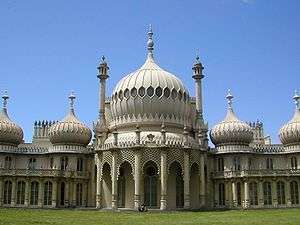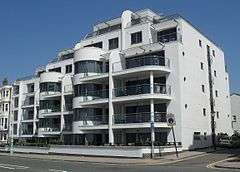St Peter's Church, Brighton
St Peter's Church is a church in Brighton in the English city of Brighton and Hove. It is near the centre of the city, on an island between two major roads, the A23 London Road and A270 Lewes Road. Built from 1824–28 to a design by Sir Charles Barry, it is arguably the finest example of the pre-Victorian Gothic Revival style. It is a Grade II* listed building.[1] It was the parish church of Brighton from 1873 to 2007 and is sometimes unofficially referred to as "Brighton's cathedral".[2]
| St Peter's Church, Brighton | |
|---|---|
The church seen from the liturgical west | |

| |
| 50°49′42.11″N 0°8′5.98″W | |
| Denomination | Church of England |
| Churchmanship | Evangelical |
| Website | http://www.stpetersbrighton.org |
| History | |
| Dedication | Saint Peter |
| Administration | |
| Parish | Brighton, St Peter |
| Deanery | Brighton |
| Archdeaconry | Chichester |
| Diocese | Chichester |
| Province | Canterbury |
| Clergy | |
| Vicar(s) | Archie Coates (from Sept 2009) Jonny Gumbel (from Sept 2009) |
History
St Peter's Church was founded as a chapel of ease associated with Brighton's oldest church and its existing parish church, St Nicholas. The contract to design the new church was won in open competition by Charles Barry, then only in his mid-twenties. It was built in an approximation of the 14th- and 15th-century Perpendicular or Late Gothic style, typical of the so-called Commissioners' churches, of which St Peter's was one. It was not a revival of its style in the manner of Barry's pupil Augustus Pugin, but, as Nikolaus Pevsner described it, "[it] remedies this fault by remarkable inventiveness and boldness".[3]
The foundation stone was laid by the Vicar of Brighton, Rev. R. J. Carr dd, on 8 May 1824,[4] at a location which was at the time "the entrance to the town"[5] but which is now in the city centre, following the rapid development of Brighton since that date. The ceremony of consecration was led by the same man on 25 January 1828.
A spire was designed by Barry in 1841, but it was never built. The side aisles originally had galleries (such as those to be seen at churches such as Christ Church, Spitalfields), but these were taken down, as were so many, as a result of the cultural and liturgical changes made in the wake of the Oxford Movement.
Barry's hexagonal apse was demolished in 1898 to make way for a much larger, straight-ended chancel designed by Somers Clarke and J.T. Mickelthwaite, built in Sussex sandstone, its warm hue contrasting with the cold, white appearance of the Portland stone in which the rest of the church was built. The building work continued until 1906.[6] The new chancel, 53 feet (16 m) long and 35 feet (11 m) wide,[7] was consecrated in the presence of the then Archbishop of Canterbury, the Most Reverend Randall Thomas Davidson.
The church has a selection of stained glass windows, most of which are by Charles Eamer Kempe. The liturgical east side (geographical north) has a window commemorating Queen Victoria, presented to the church on behalf of the people of Brighton[8] using funds raised in the town.[9]
St Peter's was listed at Grade II* on 24 March 1950.[1] As of February 2001, it was one of 70 Grade II*-listed buildings and structures, and 1,218 listed buildings of all grades, in the city of Brighton and Hove.[10]
St Peter's parish was legally united with that of the Chapel Royal in North Street from 25 July 1978 by means of an Order in Council.[11]
HTB church plant
In December 2007, after a long period of consultation, the Diocesan Pastoral Committee recommended to the Church Commissioners that St Peter's should be made redundant.[12][13]
On 8 May 2009, Holy Trinity Brompton Church in London, an influential Church of England parish church which created the Alpha course, agreed to take over its ownership and running. The parish of St Peter's, previously merged with that of the Chapel Royal, was reconstituted as a separate and smaller parish.[14]
Services restarted on Sunday, 1 November 2009. The vicar is Archie Coates and the associate vicar is Jonny Gumbel, the son of Nicky Gumbel who developed the Alpha Course.
Since then the church has grown to "almost 1000"[15] and has a focus on social action, especially through a project known as Safehaven to help homeless people. There are four services on a Sunday: a liturgical Holy Communion at 8.00 am, two family services at 9.30 and 11.30, and a student and youth-oriented service at 6:30 pm. St Peter's has a satellite church on the Whitehawk estate, known as St Cuthman's, and has also planted a church in Holy Trinity Church, Hastings. In August 2016, the vicar and 30 parishioners moved to Portsmouth to start Harbour Church, a church plant in the city centre "aimed specifically at students and young adults".[16]
Organ
St Peter's has a large pipe organ[17] built in 1888 for the Hampstead Conservatoire of Music by Henry Willis[18] and brought to Brighton in 1910. It is the sole survivor of three almost identical instruments in the town, the others having been at the Dome Pavilion[19] and in Hove Town Hall.[20] The latter is now at Haberdashers' Aske's Boys' School in Elstree,[21] while the former was broken up in the 1930s. It is almost identical to the famous organ in Cathedral of the Blessed Virgin Mary, Truro. The organ in St. Peter's has been unusable for some years due to asbestos.
Bells
The tower of St Peter's currently houses 10 bells, all of which were cast in 1914 by Mears and Stainbank of London.[22][23]
Photo gallery
 The West end and War Memorial
The West end and War Memorial The arch in the liturgical west face of the tower
The arch in the liturgical west face of the tower Three windows on the liturgical south side of the later Chancel
Three windows on the liturgical south side of the later Chancel Two windows, on the liturgical south side, the one on the left in the original Nave, the one on the right in the later Chancel
Two windows, on the liturgical south side, the one on the left in the original Nave, the one on the right in the later Chancel A window on the liturgical south side of the original Nave
A window on the liturgical south side of the original Nave Looking across the church from the liturgical south-east
Looking across the church from the liturgical south-east St Peter's Church, Brighton, undergoing maintenance work in January 2015
St Peter's Church, Brighton, undergoing maintenance work in January 2015
See also
References
- Historic England (2007). "Church of St Peter (Brighton Parish Church), St Peter's Place, Brighton (1380903)". National Heritage List for England. Retrieved 14 January 2010.
- "Brighton's cathedral welcomes hundreds to reopening". The Argus.
- Nairn & Pevsner 1965, p. 435.
- Harrison 1934, p. 9.
- Hamilton Maugham 1922, p. 17.
- Harrison 1934, p. 18.
- Harrison 1934, p. 13.
- Hamilton Maugham 1922, p. 20.
- Harrison 1934, p. 12.
- "Images of England — Statistics by County (East Sussex)". Images of England. English Heritage. 2007. Archived from the original on 27 December 2012. Retrieved 27 December 2012.
- "No. 47603". The London Gazette. 28 July 1978. p. 9085.
- "Two weeks to save church". The Argus website. Newsquest Media Group. 2007-02-09. Retrieved 2008-02-06.
- "December 2007 — Proposed Redundancy". St Peter's Church website. St Peter's Church Brighton. 2007. Archived from the original on 2006-05-03. Retrieved 2008-02-06.
- "Brighton's St Peter's Church saved". The Argus website. Newsquest Media Group. 2009-05-08. Retrieved 2009-05-08.
- Go Forth And Multiply, The Economist, 17 Jan 2015
- "Brand new church launches in city centre". Anglican Diocese of Portsmouth. 23 August 2016. Archived from the original on 14 March 2017. Retrieved 14 March 2017.
- "NPOR - Brighton, St Peter's: the Willis organ". The National Pipe Organ Register. British Institute of Organ Studies. 2003. Retrieved 2007-03-10.
- "NPOR - Hampstead Academy of Music: the Willis organ". The National Pipe Organ Register. British Institute of Organ Studies. 2003. Retrieved 2007-03-10.
- "The National Pipe Organ Register".
- "The National Pipe Organ Register".
- "The National Pipe Organ Register".
- https://dove.cccbr.org.uk/detail.php?searchString=brighton&Submit=+Go+&DoveID=BRIGHTON+P
- https://www.scacr.org/towers/directory/29-brighton-st-peter
Bibliography
- Dale, Antony (1989). Brighton Churches. London EC4: Routledge. ISBN 0-415-00863-8.CS1 maint: location (link) CS1 maint: ref=harv (link)
- Hamilton Maugham, H. (1922). Some Brighton Churches. London: Faith Press Ltd.CS1 maint: ref=harv (link)
- Harrison, Frederick (1934). The Parish Church of Brighton. Hove: The Southern Counties Publishing & Advertising Co. Ltd.CS1 maint: ref=harv (link)
- Nairn, Ian; Pevsner, Nikolaus (1965). The Buildings of England: Sussex. Harmondsworth: Penguin Books. ISBN 0-14-071028-0.CS1 maint: ref=harv (link)

.jpg)
.jpg)
